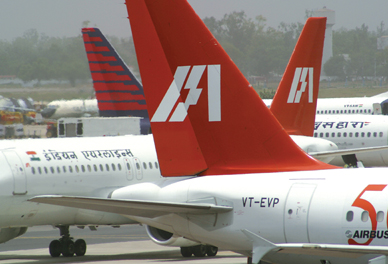INDIAN ARMED FORCES CHIEFS ON
OUR RELENTLESS AND FOCUSED PUBLISHING EFFORTS

SP Guide Publications puts forth a well compiled articulation of issues, pursuits and accomplishments of the Indian Army, over the years

I am confident that SP Guide Publications would continue to inform, inspire and influence.

My compliments to SP Guide Publications for informative and credible reportage on contemporary aerospace issues over the past six decades.
Indian Scenario - Present Tense

Advent of a slew of LCCs perhaps led to over-capacity, under-pricing and a tariff cold war that set the scene for the current haemorrhage in the industry. Further bloodshed has been caused by the fuel price rise. Sieving through the turmoil, here’s a close look at the survival and growth strategies adopted by some of the key sectors—airlines, cargo and MRO.
A dull sense of expectation pervades those watching the Indian aviation scene. Among these observers is one section that is perversely and morbidly on the lookout for the first airline to fold up. Others, the majority, would like to believe that the current state of aviation is a passing phase and that the right decisions and actions will propel the industry to a level of vibrant enthusiasm prevalent during 2003-04.
An overview of Indian aviation per force must be in the context of the global aviation state of affairs. Worldwide, at least 30 airlines have shut down since 2008—the reasons have been variegated but rising fuel prices and, more recently, the burn down in US economy, have been major contributing factors for some disturbing quantitative trends. Funding for airlines has become harder to access, fuel hedging has suddenly become dangerously speculative, and thus unattractive as a risk management option, insurance and re-insurance for aircraft and other airline assets has become more speculative, and customer confidence in airline stocks has displayed mild tremors. On an aside, the rupee—hit by risk aversion and bank actions—posted a huge fall down to around Rs 47 to a $. At the same time, perhaps even before the US economic troubles started showing up, the sustained high levels of oil prices (and consequently aviation fuel prices) had been bleeding the global aviation industry in an unacceptable manner.
Fortunately, after peaking at around $150 a barrel, oil prices came down to around two-thirds that level, providing some vital resuscitation to an industry gasping for breath. However, some damage has been done to global aviation trends which were showing signs of healthy growth before fuel prices began a choppy ascent to dizzying levels. Indeed, some industry luminaries—British Airways’ Willie Walsh, for one—believe the crisis is far from over and that it will be deep and protracted.





